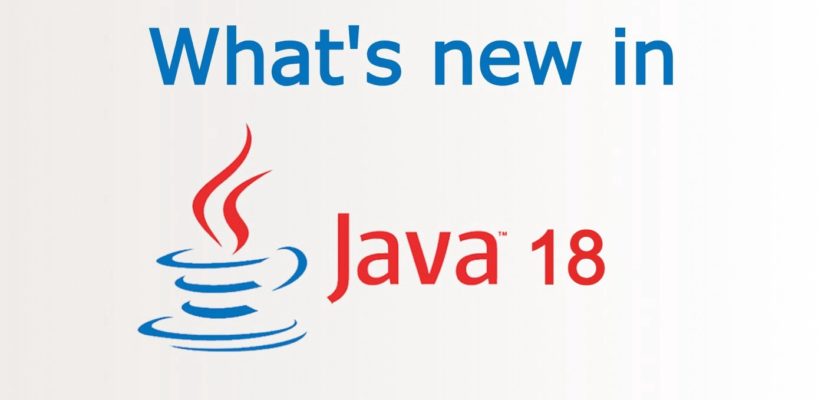
Java 18 Arrived: What is new for Application Development in 2022?
Oracle has announced general availability of Java 18 on March 22. New version will offer users new capabilities to improve software development practices. Java 18 is inherited many features from Java 17 release, which was released in September 2021 as Long Term Support (LTS) update. On the other hand, Java 18 is not an LTS but an incremental update with support offered for only six months. It majorly comprises of updates for code libraries and tools. Besides previews for technologies are present that are currently in development phase.
Java is the most used programming languages across the globe. Since its launch three decades back, the developers are contributing continuously to the development of this programming language. JDK’s is released on regular basis with remarkable features embedded into it. Developers look for opportunity to see what new they can integrate into the language. The latest iteration in the JDK family is Java 18 with some astonishing features. Let’s discuss them in detail for better project development.
Features of Java 18 to Consider in 2022
1. Vector API
Vector API was first released as an incubating API in JDK 16, which was again upgraded with the release of JDK 17 in 2021. The core reason behind its introduction is to provide an API to express vector computations that compile at runtime. This results into superior performance with scalar computations.
In Java 18, Vector API is added ARM Scalar Vector Extension (SVE) platform. A degree of parallelization is present which will assist developer to do perform more work in a single CPU cycle. It even enhance performance of vector operations on masking supported hardware. It will offer benefits including Clear and concise API, trustworthy real-time compilation and performance on AArch64 architectures, and graceful degradation.
2. UTF-8 by default
UTF-8 is a variable-wide character encoding for electronic communication. It is the default charset on the internet. But with new JDK 18, it will also be the default charset for standard Java APIs. With this new change, the APIs running on UTF-8 will behave consistently on the operating systems, locales, as well as configurations.
The primary objective of this update is to make programs in Java portable. As these programs rely on UTF-8 charset, now they can simply work with different operating systems easily. It will standardize UTF-8 all through the standard Java APIs, apart from console I/P.
3. Code Snippets
This update consists of @snippet tag for Javadoc’s Standard Doclet. It will ease the inclusion of example source code inside the API documentation. JDK 18 will facilitate Java Development Company to enable modern stylings, including syntax highlighting and automatic linkage of names to declarations. It will assist IDE support to create and edit snippets. Java 18 will assist fragments for source code validation. It will offer API access to the fragments helping author to achieve correctness as enhanced support in Javadoc will make it easier.
4. Pattern Matching for Switch
Pattern Matching for Switch was earlier released in JDK 17 like a preview feature. This update is the second preview of this feature with a few refinements based on the user’s experience and first preview feedback. It was first released with the objective to enhance the Java language program with pattern matching for switch expressions and statements.
The enhancements to the first preview comprise constant case labels to appear before a guarded pattern of the similar set by dominance checking. It will boost the readability. Reliability of switch blocks will now be more accurate with sealed hierarchies.
5. Foreign Function and Memory API
This feature was first released with JDK 17 as an incubating API. It was the API integrated with two APIs: Foreign-Memory access API and Foreign linker API. The earlier API has been re-incubating and added to JDK 18 by performing changes. The major changes include support for more carriers, general dereference API, a simpler API to access down call method handles. It is a simple API to address temporal dependencies among resource scope. It is like an API that will simply copy Java arrays to and from memory segments.
Frequently Asked Questions
1. What will be in Java 18?
The OpenJDK page lists the following features as officially targeting JDK 18: a service provider interface, a simple web server, a third incubation of the vector API, code snippets, a reimplementation of core reflection, a UTF-8 charset, a second incubator of a foreign function and memory API.
2. What is Java programming?
Java is a general-purpose programming language that is concurrent, class-based, object-oriented, and particularly designed to have as few dependencies. A virtual machine, called the Java Virtual Machine (JVM), is used to run the byte code on every platform.
3. Why is Java used for Web applications?
Java is the first name that can be used for building complex web applications and for the software platform that used this programming language. It is widely used by development companies to build secure, robust and scalable web applications.
4. How much does it cost to develop a web application?
The cost of web application development is calculated on the basis of features and functionality needs to be integrated within.
5. What is a Java Web application?
A Java web application is a collection of dynamic resources and static resources. A Java web application is easily deployed as a Web Archive file.
Wrapping Up:
In Java 18, there are some remarkable features and updates that help developers in web application development. For example, Java 18 feature introduces pattern matching for switch, foreign function, code snippets to build amazing applications. All these features make it perfect choice for application development and other customization work. You can hire Java developers to meet your business web application development requirement. They will give you proper solution to take your business to next level in the most streamlined manner with proper data security.

